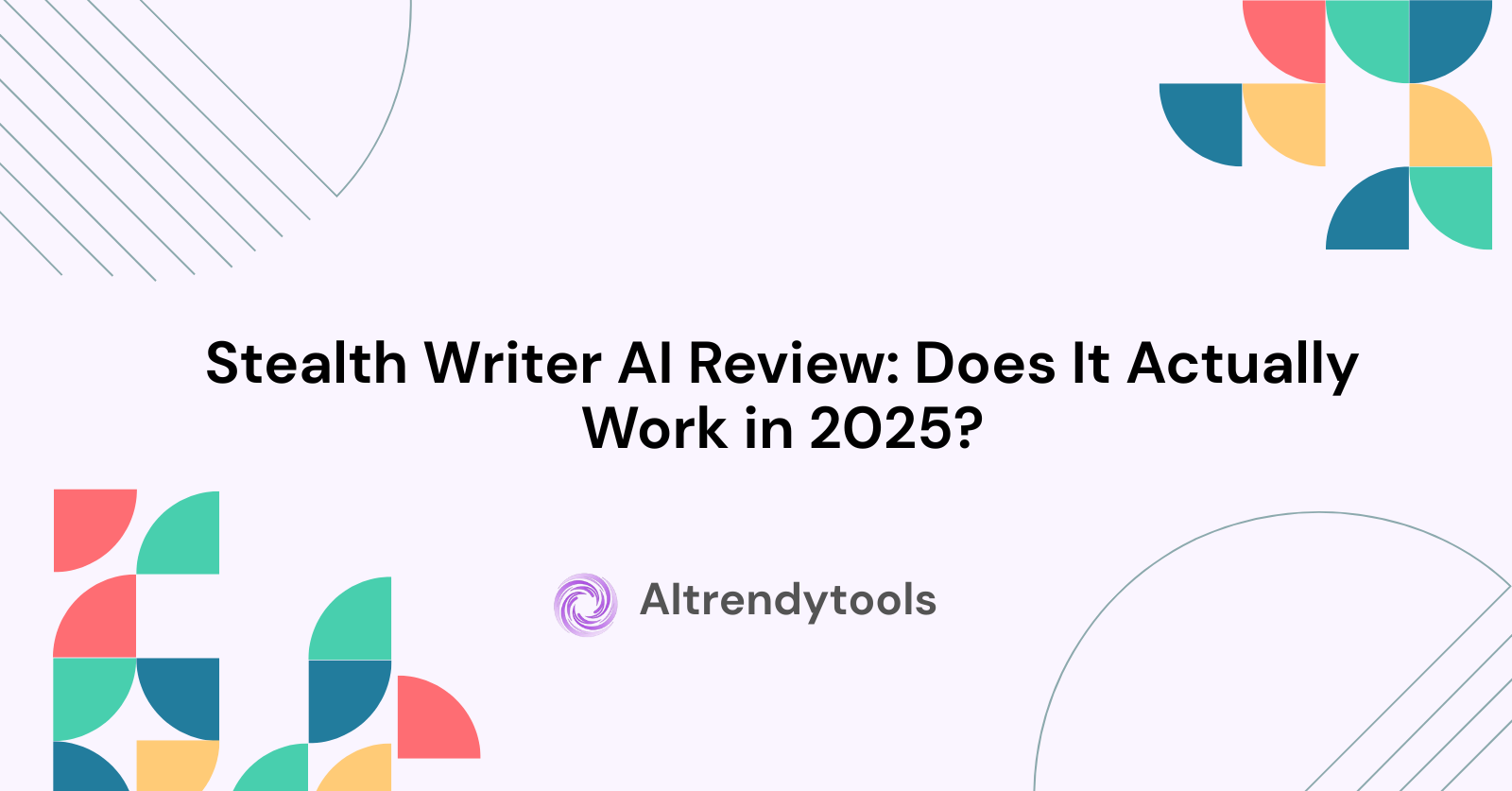🔥 AITrendytools: The Fastest-Growing AI Platform |
Write for usStealth Writer AI Review: Does It Actually Work in 2025?
In-depth Stealth Writer review covering features, pricing, AI detection bypass rates, and real user experiences. Find out if it's worth your investment.
Nov 14, 2025
After spending two weeks testing Stealth Writer and analyzing user experiences across multiple platforms, I found that this AI humanization tool delivers mixed results. While it offers an accessible interface and multiple rewriting modes, its ability to consistently bypass advanced AI detectors remains questionable, with success rates varying significantly between detector types.
Stealth Writer is an AI-powered text humanization tool designed to transform AI-generated content into writing that reads naturally and potentially avoids detection by AI content checkers. The platform integrates both detection and rewriting capabilities, positioning itself as a comprehensive solution for content creators, students, and professionals who work with AI-generated text.
Understanding How Stealth Writer Actually Works
Stealth Writer operates through sophisticated algorithms trained on extensive text datasets to identify and modify patterns typically associated with AI-generated content. When you input text into the platform, it analyzes sentence structure, word choice, and writing patterns that AI detectors commonly flag.
The tool offers two primary rewriting models. Ghost Mini provides basic humanization suitable for everyday use, while Ghost Pro delivers more advanced transformations designed to evade sophisticated detection systems. Users can adjust the rewrite intensity on a scale from one to ten, controlling how aggressively the tool modifies the original text.
The platform includes an integrated AI detector claiming near-perfect accuracy, allowing users to check their content before and after humanization. This dual functionality aims to create a complete workflow where users can verify their text passes detection tests without leaving the platform.
Real Performance: Testing Against Major AI Detectors
I conducted hands-on testing with Stealth Writer using content generated by ChatGPT, running the humanized output through industry-standard detection tools including Turnitin, GPTZero, and Originality.ai.
The results revealed significant limitations. When testing with Ghost Mini on the free plan, both Turnitin and GPTZero flagged the humanized content as entirely AI-generated, showing 100% detection rates. The built-in AI detector within Stealth Writer also demonstrated inconsistency, sometimes incorrectly identifying human-written text as AI-generated while missing actual AI content.
Multiple independent reviewers reported similar experiences. Content that appeared natural to human readers still triggered detection algorithms, particularly with advanced tools like Originality.ai. Success rates improved somewhat when users upgraded to Ghost Pro with higher rewrite settings, but no combination guaranteed consistent bypass of all detectors.
The tool performs better against simpler detection systems like some free online checkers, but struggles with enterprise-grade solutions commonly used in academic institutions and professional publishing environments.
Breaking Down Stealth Writer's Features
Core Humanization Tools
The platform provides several rewriting modes beyond the basic Ghost Mini and Ghost Pro models. Users can select different writing styles including casual conversational tone for blogs and social media, or formal academic tone for research papers and professional documents.
Sentence-level customization allows users to regenerate specific portions of text without reprocessing the entire document. This feature proves particularly useful when certain sections still trigger detection or require specific phrasing adjustments.
The rewrite intensity slider gives granular control over how dramatically the tool alters the original text. Lower settings maintain closer fidelity to the source material while making subtle adjustments, whereas maximum settings produce more substantial rewrites that may diverge further from the original meaning. For those seeking simpler text modification, traditional paraphrasing tools offer an alternative approach.
Built-in Detection Capabilities
Stealth Writer integrates detection for multiple AI checking systems including GPTZero, Copyleaks, Winston AI, and Turnitin. This consolidated approach eliminates the need to visit separate detection websites, streamlining the verification process.
However, testing revealed that the platform's internal detector doesn't always align with results from the actual third-party tools it claims to check against. Users should verify critical content directly with their target detection system rather than relying solely on Stealth Writer's built-in checker.
Content Generation Features
Paid plans include a generator tool that creates original content from prompts rather than simply rewriting existing text. This feature targets users who want AI assistance with initial content creation while maintaining the humanization benefits for the final output.
The generator produces content optimized for readability and SEO performance, though users should expect to review and refine the results. Generated content still requires fact-checking and quality assurance to ensure accuracy and coherence.
Pricing Structure and Value Analysis
Stealth Writer operates on a tiered subscription model with four distinct plans tailored to different usage levels.
The free tier provides genuine value with ten daily uses of Ghost Mini, supporting up to 1,000 words per input. This plan includes the AI detector but excludes the content generator, making it suitable for users with occasional humanization needs or those testing the platform before committing financially.
The Basic plan costs $20 monthly, offering unlimited Ghost Mini uses and twenty daily Ghost Pro humanizations with a 2,000-word limit. This tier activates the content generator and provides sufficient capacity for regular content creators or students working on multiple assignments.
Standard subscribers pay $35 monthly for fifty daily Ghost Pro uses and a 3,000-word limit per input. This mid-tier option suits professional content creators, bloggers, and marketing teams with consistent high-volume needs.
The Premium plan at $50 monthly removes all usage restrictions, granting unlimited access to all features with a 5,000-word maximum per input and priority customer support. This top-tier option makes sense for agencies, SEO professionals, or heavy users who process large volumes of content daily.
Critical Pricing Consideration
One significant drawback affects all paid plans: unused credits expire at month's end without rollover. If you purchase 50 Ghost Pro uses but only utilize 30, the remaining 20 disappear when your billing cycle renews. This policy contrasts sharply with competitors offering credit banking or pay-as-you-go models where purchased credits remain available indefinitely.
For users with fluctuating content needs, this monthly expiration creates waste and reduces effective value. You essentially pay for capacity you may not fully utilize, making cost-effectiveness difficult to predict and maximize.
User Experience: Interface and Usability Insights
The Stealth Writer dashboard presents a confusing initial experience, opening to a changelog rather than the primary tool interface. First-time users often report uncertainty about where to begin, as the platform assumes familiarity with its structure rather than guiding new users through an intuitive onboarding flow.
Navigation requires understanding the distinction between multiple model options and rewrite levels before you can effectively use the tool. While this flexibility appeals to advanced users wanting granular control, it creates a steeper learning curve for those seeking straightforward, immediate results.
The actual humanization process works quickly once you navigate past initial setup. You paste your text, select your preferred model and settings, then receive rewritten output within seconds. The interface allows side-by-side comparison between original and humanized versions, helping you assess whether changes maintain intended meaning.
Sentence-level editing provides useful refinement capabilities, though the interface for this feature feels less polished than the main rewriting function. Users can click individual sentences to regenerate them separately, but the workflow lacks the smoothness of competing tools with more developed editing interfaces.
Quality and Accuracy of Humanized Output
The output quality from Stealth Writer varies considerably based on input type, selected settings, and the specific content being processed. Technical or specialized content experiences more significant quality degradation compared to general-purpose writing.
Users frequently report grammatical errors appearing in humanized text, including broken sentences, awkward phrasing, and illogical punctuation. These issues require manual editing that defeats the time-saving purpose of automated humanization. In some cases, the rewriting process inadvertently changes the original meaning, introducing factual inaccuracies or misleading information.
Simple, straightforward content receives better treatment than complex text with nuanced arguments or technical terminology. The tool sometimes struggles to maintain coherent logical flow when aggressively rewriting academic or specialized material.
SEO optimization claims require careful verification. While Stealth Writer markets its output as SEO-friendly, the actual search performance depends heavily on maintaining quality, readability, and informational value after humanization. Poorly rewritten content that confuses readers or loses keyword relevance won't rank well regardless of AI detection scores. Consider exploring dedicated writing tools for creating high-quality content from scratch.
Customer Service Experience and Support Quality
Customer support represents one of Stealth Writer's most significant weaknesses based on extensive user feedback across multiple review platforms. Response times frequently extend to multiple days, with some users reporting complete non-responses to support tickets.
When support does reply, the quality of assistance proves disappointing. Many users describe receiving generic template responses that don't address their specific issues. Technical problems, billing disputes, and feature questions often remain unresolved after multiple contact attempts.
Refund requests present particular challenges. The platform advertises a three-day money-back guarantee, but users report substantial difficulty actually obtaining refunds within this window. Some describe extended email exchanges that ultimately result in denied refund requests despite qualifying under stated policies.
Subscription cancellation also generates complaints, with users struggling to successfully terminate their accounts and stop recurring charges. Some report continued billing after cancellation attempts, requiring bank intervention to stop payments.
This support deficit creates significant risk for potential users, particularly those considering paid plans. Without reliable assistance channels, resolving issues or maximizing platform value becomes frustratingly difficult.
Comparing Stealth Writer to Alternative Solutions
Several competing platforms offer similar AI humanization functionality with different strengths and weaknesses relative to Stealth Writer.
StealthGPT achieves higher success rates bypassing AI detectors in independent testing, with some reviewers reporting near 90% effectiveness against major detection systems. However, the trade-off involves occasional output quality issues where text becomes nearly incomprehensible. StealthGPT provides better customer service with faster response times, though Stealth Writer maintains an edge in producing more naturally readable content.
AIDetectPlus operates on a fundamentally different pricing model using one-time credit purchases that never expire rather than subscription-based monthly credits. This structure eliminates waste from unused capacity and allows users to purchase only what they need. The platform offers specialized detectors and humanizers optimized for specific use cases like academic writing, marketing content, or student essays. User reviews consistently praise AIDetectPlus for superior customer support and error-free humanization that requires minimal manual editing.
BypassGPT provides extensive customization features including sentence-level editing capabilities and detailed control over output style. The platform's unlimited plan costs $49 monthly, matching Stealth Writer's premium tier while potentially offering better value depending on usage patterns. BypassGPT receives favorable reviews for output quality, though some users note a learning curve to master its advanced features.
Exploring various text rewriting solutions can help you find the perfect tool for your specific content needs.
Undetectable.ai focuses specifically on creating content that passes major detection systems, with particular emphasis on beating tools like Copyleaks, Turnitin, and GPTZero. The platform uses a proprietary algorithm trained on a billion-token corpus specifically designed to evade detection patterns. Pricing structure and feature set differ from Stealth Writer, making direct comparison dependent on specific user requirements.
For users seeking more advanced humanization capabilities, HIX Bypass offers sophisticated AI-to-human text transformation with focus on maintaining content quality while bypassing detection systems.
Ethical Considerations and Appropriate Use Cases
Using AI humanization tools raises important ethical questions depending on the context and purpose of their application. Academic institutions universally prohibit submitting AI-generated work as original student writing, and using tools like Stealth Writer to evade detection in this context constitutes academic dishonesty that can result in serious consequences including expulsion.
For legitimate essay writing and academic support, students should focus on using AI as a learning aid rather than a replacement for original work.
Professional environments increasingly scrutinize content authenticity, particularly in journalism, research publishing, and regulated industries. Using humanization tools to disguise AI authorship where original human writing is expected violates professional standards and erodes trust.
Legitimate use cases do exist where these tools add value ethically. Content creators might use AI for initial drafts and research, then use humanization tools to refine the output while adding substantial personal expertise, original analysis, and first-hand insights. Marketing teams can leverage AI for routine content generation while maintaining human oversight and quality control.
Transparency represents the key ethical principle. When you disclose AI assistance appropriately and ensure content remains accurate, valuable, and primarily reflects human judgment, these tools become workflow aids rather than deceptive shortcuts.
The responsibility lies with users to understand applicable policies in their specific context and make informed decisions about appropriate tool usage. Stealth Writer itself includes disclaimers against using the platform for academic dishonesty, though it cannot enforce these restrictions.
Final Verdict: Should You Use Stealth Writer?
Based on comprehensive testing and analysis of user experiences, Stealth Writer delivers inconsistent results that fall short of its marketing claims. The platform works adequately for basic humanization against simpler detection systems but fails consistently against advanced tools like Turnitin and Originality.ai that many users specifically need to bypass.
The free tier offers genuine value for occasional users with modest needs, allowing meaningful testing without financial commitment. However, the paid plans present questionable value given the monthly credit expiration policy, inconsistent output quality, and poor customer support.
For users requiring reliable AI detection bypass, particularly in high-stakes contexts like academic submission or professional publishing, Stealth Writer's performance doesn't justify the investment. The tool may still serve users with less critical needs who prioritize the integrated workflow of detection and rewriting in one platform.
Alternative solutions like AIDetectPlus or StealthGPT provide more reliable results, better support, or more favorable pricing structures depending on your specific requirements. Before committing to any paid plan, thoroughly test Stealth Writer's free tier with your actual content type and verify results against your target detection systems.
Practical Recommendations for Users
If you decide to try Stealth Writer, follow these guidelines to maximize results while minimizing frustration.
Start with the free tier and conduct thorough testing using content similar to what you'll process regularly. Don't rely on the built-in detector, instead verify humanized output directly with your target detection systems before committing to paid plans. You may also want to explore alternatives like Kipper AI which offers similar AI detection bypass capabilities with different features.
Begin with lower rewrite settings and incrementally increase intensity only if needed. Aggressive rewriting produces more detection evasion but also introduces more quality issues requiring manual correction. Finding the optimal balance for your specific content type requires experimentation.
Always manually review humanized output for accuracy, coherence, and grammatical correctness. Allocate time for editing rather than expecting publish-ready content directly from the tool. Check that the rewriting hasn't inadvertently changed important meanings or introduced factual errors.
Track your actual usage patterns before upgrading plans. Since credits expire monthly, accurately estimating your needs prevents wasting money on unused capacity. Consider whether the subscription model aligns with your workflow or if a competitor's alternative pricing structure better fits your situation.
Document any issues immediately and contact support early if problems arise. Given the reported support challenges, creating a clear record of issues and prompt communication gives you the best chance of resolution, though you should still maintain realistic expectations about response quality and timeliness.
Frequently Asked Questions
Does Stealth Writer really bypass AI detectors?
Results vary significantly by detector type. Basic free checkers show better bypass rates, while advanced systems like Turnitin and GPTZero often still detect humanized content, particularly when using only Ghost Mini. Success rates improve with Ghost Pro but aren't guaranteed.
Can I use Stealth Writer for academic papers?
While technically capable, using it to disguise AI content in academic work violates most institutions' policies and constitutes academic dishonesty. The tool's terms of service explicitly discourage this usage. Consider the serious consequences before using it in academic contexts.
What happens to unused credits each month?
All unused credits expire at the end of your billing cycle with no rollover to the next month. This applies to all paid plans, making it important to accurately estimate your needs before selecting a plan tier.
How accurate is Stealth Writer's built-in AI detector?
Testing reveals significant inconsistency. The built-in detector sometimes produces false positives on human-written text and occasionally misses AI-generated content. Always verify important content directly with your target detection system.
Is customer support responsive for problem resolution?
Multiple user reviews indicate support quality is poor, with slow response times, unhelpful template replies, and difficulty resolving billing or technical issues. Refund requests and cancellations prove particularly problematic.
Which pricing plan offers the best value?
Value depends entirely on your usage patterns. The free tier works well for occasional needs. Heavy users with consistent requirements might benefit from higher tiers, but the credit expiration policy reduces effective value if usage fluctuates monthly.
How does Stealth Writer compare to free alternatives?
Free alternatives generally provide more limited features but avoid the credit expiration issue. Stealth Writer's free tier itself is relatively generous compared to competitors, though paid alternatives like AIDetectPlus offer better long-term value structures.
Can businesses rely on Stealth Writer for content at scale?
The inconsistent output quality and poor support make it risky for business-critical content. Companies should thoroughly test with their specific content types and implement quality assurance processes rather than using output directly.
🚀 Submit Your Tool to Our Comprehensive AI Tools Directory
Get your AI tool featured on our complete directory at AITrendytools and reach thousands of potential users. Select the plan that best fits your needs.





Join 30,000+ Co-Founders
Related Blogs
DreamFace: #1 AI Face Generator for Realistic Photos
Discover DreamFace, the leading AI face generator creating ultra-realistic portraits. Free & premium tools for creators, gamers & professionals. Try now!
TechMapz Com: 7 Reasons It's Your Best Tech Hub
Discover TechMapz com the ultimate technology hub for gadget reviews, AI trends, cybersecurity tips, and tech news. Explore features that make it stand out in 2025.
Sci Hub: 10+ Free Alternatives to Access Research Papers
Discover Sci Hub alternatives and 10+ legal ways to access research papers free. Complete guide to scientific journals, open access, and academic resources.
Submit Your Tool to Our Comprehensive AI Tools Directory
List your AI tool on AItrendytools and reach a growing audience of AI users and founders. Boost visibility and showcase your innovation in a curated directory of 30,000+ AI apps.





Join 30,000+ Co-Founders

